
May 30, 2005
SO YOU WANT TO GET YOUR FEET WET
BUT NOT YOUR CAMCORDER
By Steve Douglas
You're a scuba diver and you want to start shooting underwater video to entertain your friends and associates, enter film festivals and competitions or simply to extend the diversity of your shooting skills.
I would venture to guess that 98% of all my video work is done under water where a whole new set of rules and guidelines wait for me, and now you. The basics are all the same, steady shot, watch your composition, check your white balance, and adjust the lighting, but all the things we take for granted topside are major obstacles to shooting underwater. What you easily accomplish on land is thrice as inconvenient and difficult down below.
First, lets take a look at equipment. You will need a camcorder. I will not get into the merits of using a 3-chip cam like the Sony DCR VX 2000, which is my current camcorder, or a single chip or even the new Sony or JVC HD cams. The important thing before purchasing a camcorder is to MAKE SURE A HOUSING IS MADE FOR IT BEFORE BUYING. Housings can easily cost, and usually do, more than the camcorders themselves. I prefer a mechanical housing like Gates Underwater Products produces, while many prefer the electronically sophisticated housings such as Light and Motion, Amphibico or Sea & Sea. There are several other companies producing quality housings but these listed are the ones most often recommended.A less expensive, but quality housing is the mechanical Ikelite housing.
The advantage of the mechanical housing is that of reliability, durability and ruggedness. The electronic housings are known for their ease of use, fingertip button press controls and attractive appearance. When they work, they work wonderfully. When they don't, and you are on a boat 4,000 miles away from home, you are probably out of luck. Your shooting is done until you get back to home and can send the parts away. Getting those parts replaced and the housing repaired can take a month or more in many cases. I'm not the handyman type; I pat myself on the back for being able to put the chain back on the toilet float. Therefore, I need equipment that will not demand a whole heck of a lot of maintenance. In all my years of using a mechanical housing, I have never had a problem I couldn't take care of no matter where in the world I was shooting at the time. At this point I will own up to my strong bias favoring mechanical housings. However, keep in mind that there are a great many excellent underwater shooters whom I know and respect and who love and swear by their electronic housings. One must make that choice for themselves. Try both types out if you can, as well as educating yourself and trying out housings from different manufacturers when possible.
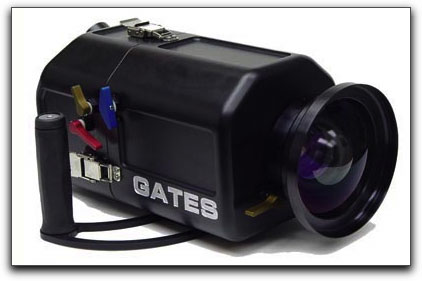
Manual housing & lever controls
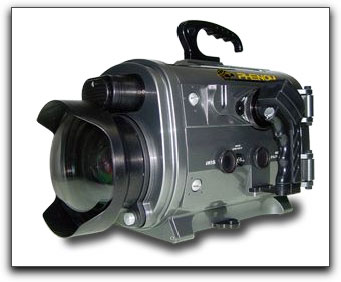
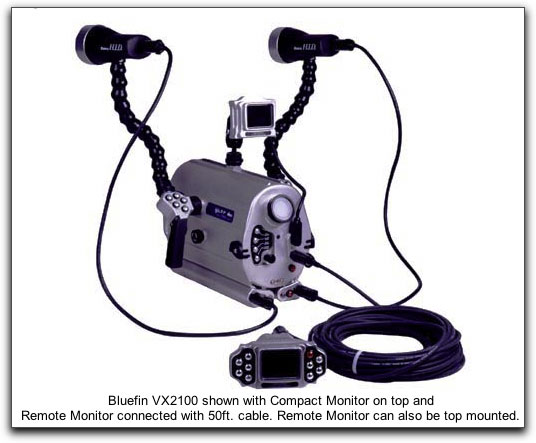
Electronic controls on handles
The most important skill all shooters learn is that it is of paramount importance to keep the camera still. Unless you are shooting an underwater version of the Blair Witch Project, an unsteady hand creates a shaky and unusable clip. We have learned how difficult it is to keep a shot steady while simply breathing in and out, hard to do while walking, and impossible while running. I guess this is the reason why so many of us buy and use a good tripod or steady cam. With a tripod and wheels we can pan, dolly and tilt to our hearts content trusting in our equipment's ability to keep that focus rock steady.
Now try and do that without the tripod, in fact, imagine yourself in a 3 knot current at 85 feet below the surface; you're trying to film a hammerhead shark while avoiding being knocked into the venomous urchin clinging to that large boulder just beyond that ridge where, you remember from the last dive, there was a treacherous down drafting current. That hammer is a large one but is afraid of your bubbles and is in danger of fleeing forcing you to miss the shot. Bottom line is that filming underwater has its own bevy of challenges, each succumbing to the particular conditions that one is diving in and the equipment you are using. The currents underwater constantly buffet a diver; sometimes they are strong and at other times the surge is almost non-existent. These conditions will certainly affect the way you approach the shot in order to keep the camcorder housing rock steady.
Since eliminating camcorder/housing movement is of maximum importance the underwater shooter must practice holding the housing still. I accomplish this by holding onto the housing handles with a light touch, sometimes, depending on the conditions, with only one hand. At other times, I find that I will hold the handle with one hand while cradling the housing from underneath with the other. This creates a 'tripod' posture which helps to maintain a static shot. Practice holding the camcorder housing when in different underwater positions to find a touch and feel that is right for you.
Practicing this will also help you master knowing where your finger controls are at all times. When using either a mechanical housing or electronic housing you are not going to be touching the controls on the camcorder itself. With an electronic housing a wired link is internally connected from the camcorder to the electronic controls within the housing. Most of your buttons controlling zoom, white balance, auto and manual focus, exposure and more, depending upon the type of housing, will be placed somewhere on the two handles to the left and right. With a mechanical housing you will be using a variety of controls which extend from the outside of your housing to the camcorder tucked nice and dry within. The mechanical levers come into physical contact with the controls on the camcorder. With a mechanical housing, such as the Gates, Ikelite and others, most of these controls are spread out along either the left or right body of the housing itself. Therefore, it is very important to know where these controls are by touch and familiarity. If, while shooting, you remove your eyes from the monitor or backplate, where the eyepiece is, you stand an excellent chance of moving the entire housing and ruining the shot. It is critical that you be able to go to any control simply by touch while still in the record mode.
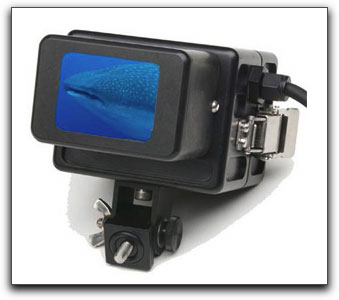
Viewing monitor attaches to top of housing
Creating an underwater film is no different than writing a story or filming a sitcom for T.V. Each story must have a beginning, middle and end. When watching a movie in the theater we would get considerably bored if every character did the same thing over and over again, or repeated their dialogue incessantly. The metaphor here is that, when shooting underwater creatures, it is necessary to film from a variety of perspectives. If I am shooting a silver tip shark passing from left to right, what makes that any different than the shot of a Napoleon Wrasse also swimming from left to right. If I film a wide angle clip of the reef in Papua New Guinea, what makes that any different than the wide angle shot of a reef in Fiji? Not a whole lot, and certainly not enough to make it interesting to a viewer. Even a serious documentary must entertain, must capture and retain the viewers interest. A serious error that many novice underwater shooters make when editing is to repeatedly use the same type of shot over and over. As in topside filming, the focal point of the shot is imperatively important. Many new underwater shooters aim that camcorder at everything that moves making almost every shot a long, wide-angled clip. If you are going to tell a story documenting the life of the giant cuttlefish in Thailand than mix those shots up. Film the divers suiting up, pan slowly over the islands blanketing the horizon. This will serve as a fine master shot to your location leading the viewer to where you want to take them. Catch the divers going into the water and then use another wide-angle master shot of the reef before cutting away to the cuttlefish themselves.
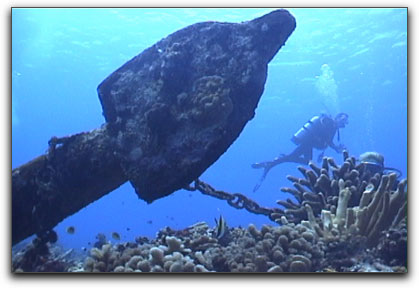
Establishing wide angle shots certainly have an important function
If one cuttle fish swims by and you caught the clip just right, will the next shot of it going by again serve any purpose? Not in the editing bay. Get that medium shot of the male coveting the female and threatening the other males with high held tentacles before guiding the female to the crack in the rock where it will lay its eggs. Now get that close up of the female thrusting its tentacles into the crevice to deposit its eggs and then back to the medium shot of it turning to swim off. Each sequence within a film should be filled of a variety of shots, angles and action.
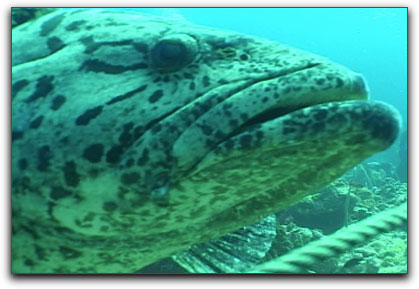
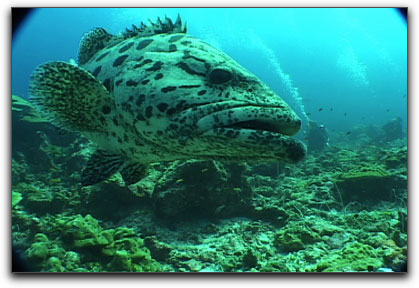
A good mix of perspectives keeps it interesting
Wide-angle shots are great when used as establishing shots but when used exclusively, they create a serious lack of diversity when redundantly repeated within the story line. I remember proudly showing off, to a dive club, one of my earliest films of an expedition to the Galapagos Islands. I had sold this short film to several people and it had also won me my first underwater film competition. One of the older and more experienced members of the club brought me aside after my showing and told me he liked the film but suggested I change my focal points more frequently. What a shock! This is the film I had worked so hard on and was so proud of, it had won a competition and yet he was able to find a way to improve it. After I got home I played the film for myself and, darn it if he wasn't right. Most of my shots were either wide angle or medium shots. There were hardly any real close-ups. Thus, when filming, remember to mix up the type of shots you are taking. Get those wide-angle shots but don't forget the close-up and extreme close-up if your system is capable of using a macro or super macro lens. Now, when I can, I will always attempt to shoot my subject's behavior from all three positions. Sometimes that is impossible, as not all turtles want to hang around as I change position and adjust focus but, when I can shoot a diversity of shots, I always do.
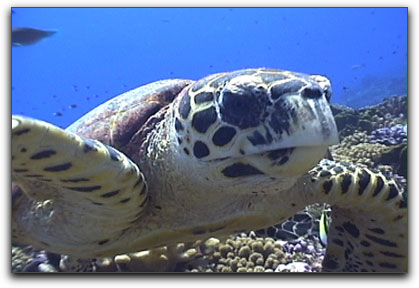
While you can't always get this close, when you can,
it will provide an interesting angle to your finished film
Attention to composition is as important underwater as it is topside. The rule of thirds within the frame still applies, however, underwater, the angle that one shoots at is another important consideration. It is always best to try to shoot marine creatures, whether they be clownfish, barracuda or shark from slightly underneath. This provides both size and depth to the creature. When one shoots downward on a fish the entire picture tends to flatten out.
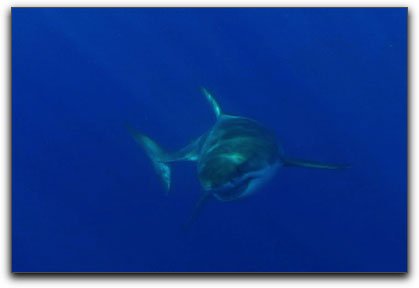
|
|
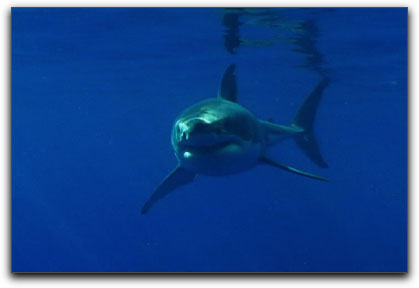
|
|
Notice how, when shooting down, the Great white appears less massive? The whole shot is less dynamic with a flattened appearance.
|
|
Shot from slightly below, this Great White comes at you with a toothy grin
guaranteed to hold your audience's attention
|
In addition, a fish is not very wide, unless you happen to be shooting a whale shark, and, thus, your fish will not take up as much of the frame as you perhaps hoped. When shooting from underneath you will not only get a clear shot of the vibrant colors of many species but also, as in the case of filming sharks, an excellent view of their mouths, teeth and eyes giving character to your subject. Shooting from the side is also fine but, even then, I try to stay a bit low with the housing aimed slightly up.
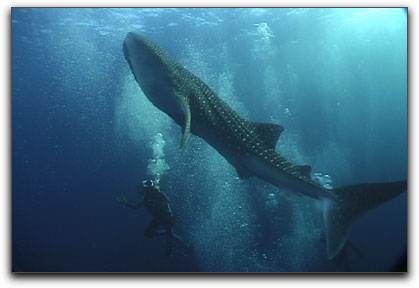
Composition and placement of the filming diver in relationship to this
whale shark, along with background bubbles, creates a sense of wonder
Fish do not take direction very well. They could care less about the demands of your storyboard. Because of this, many new shooters tend to follow the movements of the fish with their camcorder. They are either panning after the fish or tracking alongside of it. Both of these shooting methods may produce some great results, however, the novice will often do this in hopes that the creature will turn their way. However, they are frequently creating pans and tilts going in all directions as well as adding additional shake and disturbance to footage. Now following a creature from one direction to another is often just fine but the new shooter should keep it in mind to sometimes simply keep the camcorder static and allow that shark to pass from one side of the image to and through the other. It creates a fine shot and avoids the multiple pans that can bring about seasickness in anyone trying to follow along.
Zooming underwater is, more often than not, a no-no. It can be an annoying distraction from the subject and ruin the mood you are attempting to create. In addition, zooming in underwater makes it that much harder to keep the camcorder housing steady. This is especially true when attempting full zooms on macro subjects like the pygmy seahorse, which is about the size of the cuticle on your pinky finger. What I will frequently do is, with the record button turned off, zoom into my subject, properly focus and then start recording. I find that a slow zoom out from an extreme close-up to medium or wide-angle shot may be a very effective way to highlight my subject. It creates initial intimacy and wonder with my subject and then allows the viewer to see it in a larger scope in relation to its' environment. Often the reason a new underwater videographer attempts a zoom is because they were concerned why, following their last dive, and after viewing their footage, the video appeared cloudy and not as sharply focused. On this dive they figured that if they zoomed in and filled the frame they would avoid that milky appearance. The ocean, or even a lake or river, is filled with minute particulates and debris. These objects, though infinitesimal, tend to cloud the image. A considerably better solution than zooming in is to simply get closer to the subject. With less water between you and your subject you will find yourself producing a sharper and more attention-grabbing piece of marine footage.
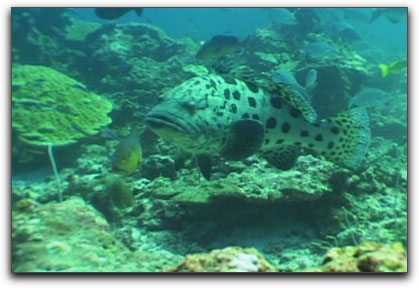
|
|
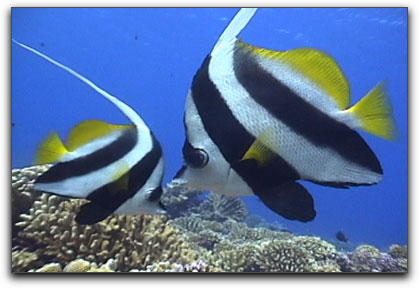
|
|
Notice the milky appearance? Not a very good shot at all
|
|
Less particulate between the shooter and the subject creates
a far sharper and more dynamic clip
|
Another tip is to avoid shooting a fish, shark or any creature with its' back end facing you. Shoot the action coming towards you and rarely going away. While it might be fine to shoot from behind a creature in order to make a personal identification for yourself, to use that clip in a film would probably be a mistake. Bottom line, it is an uninteresting shot made up primarily of the back of the fish, its' dorsal fin waving goodbye. An exception might be if a fish were coming right at you and you followed its' path as it travels overhead. Even then, you would keep the end of the clip as it passes by, very brief.
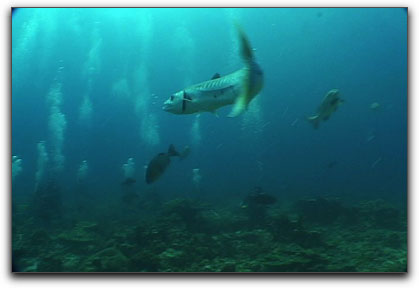
|
|
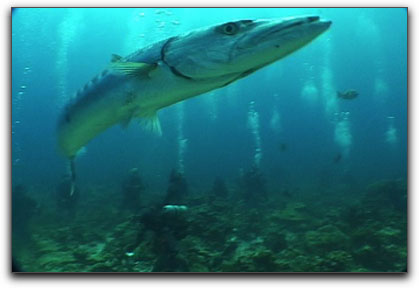
|
Shooting the rear end of a fish is something to avoid.
It adds little or nothing to your production.
|
|
Much better to see those teeth and eyes, it got my
interest as it came to check me out
|
When filming marine life it is always more important and impressive to film a behavior than to simply film the fish itself. Filming the fish doing nothing but swimming creates a dull moving snapshot. It is better to film that clownfish territorially swimming among the anemone's poisonous tentacles guarding its young, or a hammerhead hovering over a cleaning station allowing butterfly fish to clean parasites off its skin; perhaps a moray eel with a cleaner shrimp in its mouth, both getting something out of the deal. A 15 ft manta ray doing back rolls in the water is exponentially more interesting than one swimming by you. Yes, filming a colorful nudibranch is nice but shooting that same nudibranch mating or eating another nudibranch is the behavior that will sell.
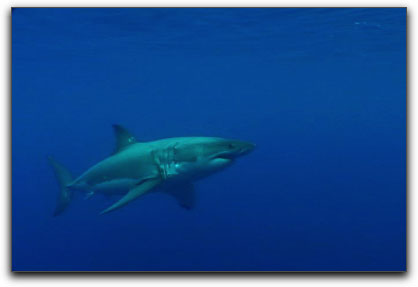
|
|
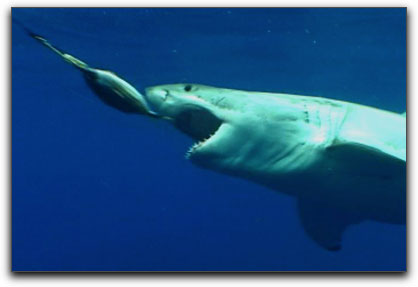
|
|
Not much going on in this shot
|
|
Action makes it a bit more interesting, wouldn't you say?
|
Since we never can predict these behaviors it is always best to start the cam while approaching and setting up underwater. Be ready for anything to occur. Hopefully, your camcorder and yourself will be positioned properly before the action starts. Keep in mind to always start shooting early and keep the camcorder recording for several seconds after the action has ended. Even if you love the shot, if you don't capture it from the beginning of the action it might very well be useless. This will help you tremendously when you get to your postproduction editing.
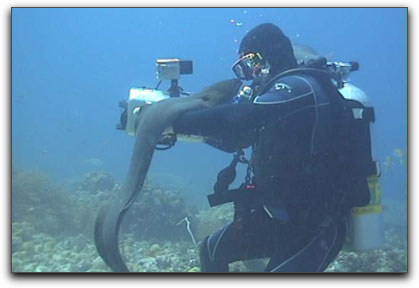
A curious moray eel came out to say hello to me up close and personal.
When filming be prepared for anything
As we dive deeper into the ocean, colors quickly dissipate. First go the reds and yellows, next the blues until all we have left at 60 ft below the surface is a vague bluish tinge on most everything. Most underwater housings have an internal UR Pro filter for blue water, while some utilize an external UR filter. The UR filter is for use at depths below 30 feet or one atmosphere below the surface. The use of this filter above 30 feet will produce a shot that looks as if you put a red screen over your lens; the entire shot will now be a pinkish red. Thus, activating the UR filter above 30ft is something to avoid. When used properly this filter is excellent for bringing back many of the lost colors but fails to bring back the full luminance I need for critical shooting. Therefore, the use of lights while shooting is extremely important whether shooting during the day or night. Lights will bring up all those magnificent colors scattered over the breadth of the coral reef and will highlight the iridescent hues of the slumbering parrotfish.
For underwater use there are primarily two types of lights to choose from. Halogen lights, which burn at about 3400 degrees Kelvin, bring, at least to my tastes, certain warmth to the shot. I especially like the use of halogens for nighttime shooting. A halogen lamp does not need any warm up time to get to its designated brightness so the instant you turn it on you are in business. However, because of their color temperature you should never use both the housing's UR filter at the same time you are using the lights. If you do, a strong reddish tinge will permeate your entire clip. The HID lights burn at almost daylight temperatures of 5800 Kelvin. To my mind they are absolutely wonderful for daylight shooting but add a somewhat bluish tinge to my nighttime shots. An HID light also needs between 12 and 20 seconds to get up to full brightness and if the action starts before the brightness levels have been reached you may be out of luck. On a positive note, an HID light may be used with or without the UR filter.
Keep in mind that your lights will have a very restricted throw. Therefore, for any subjects beyond 4 1/2 ft the lights will be almost useless. For medium and close up shots proper lighting is essential. Lights are kept on arms extended from the housing and can be positioned in the way most advantageous to the shot. Flexible, rather than set or stiff arms, are ideal, as you may need to rearrange the position of these lights underwater as you seek to film that nurse shark hiding back underneath a ledge.
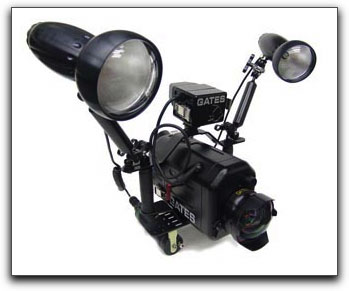
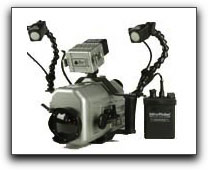
Examples of different lighting setups for mechanical and electronic housings
Most new underwater shooters tend to film with their camcorders in automatic focus. This practice works well when shooting macro or stagnant objects like the pygmy seahorse, frogfish, and a medium shot of a reef. When there is little movement by the subject the auto focus of your camcorder will work just fine. A problem arises, however, when you are shooting a wide-angle shot in open water. A shark swimming by is not a static subject and as it changes its distance from you the camcorder lens will be frequently confused as to whether to focus upon the open sea or the shark or fish. This will create a momentary lose of focus, a sudden blur if you will, which can absolutely ruin what might have been an excellent shot. I always zoom in on an object underwater, manually focus and then zoom out. Then anytime I do need to zoom into something, everything between my zoom out and original zoom in points will be properly focused. Experienced underwater shooters have their own methods of focusing underwater but I find that this simple method works best for me. The important thing is to avoid filming while in auto focus for most shots. Manual focus might take a bit more set up time underwater but will produce the best and most consistent results. Should you wear glasses and have a difficult time focusing underwater without them, there are several businesses who will place the correct lens' for your eyes onto your mask. I have been using just such a mask with good results.
Depending upon the camcorder and housing you are using, white balancing for underwater use is just as essential as it is for topside. Underwater, as you change your depth you are also changing your lighting. While I have found that most camcorders auto white balance works well, there is a significant improvement in manually white balancing. I always carry a white plastic slate with me underwater so that I may re-white balance as the conditions of my shooting change. Some have told me that they will sometimes white balance against the sand. I have never tried this but they swear that it produces good results.

Photos by John Ellerbrock
The effect of color loss underwater. Note the raw shot is very blue and 'washed out'. A color correction filter can compensate,
but only to the extent of the light frequencies being filtered, which also reduces available light by 1-2 f stops.
White balancing accurately compensates for color loss with not effect on available light
The last thing any one wants is a housing to flood. It takes but one drop of salt water to fry a very expensive camcorder. I have seen many underwater shooters accidentally flood their housing. In all these years I never thought it would happen to me. I was too careful, too anal about properly maintaining my Gates housing. Then, in the summer of 2004 I was leading a diving and filming expedition to beautiful Tahiti and the proverbial 'It" hit the fan. Not the housings fault, completely mine. I had a small piece of elastic wrist strap get caught in-between the housing backing as I closed it after a battery switch. I simply had not checked it as thoroughly as I should have. As soon as the housing dropped 2 inches below the water I was the proud owner of a $2600 Sony VX2000 doorstop. However, my housing just needed to be properly rinsed out and, with the purchase of a new camcorder, I was ready to go.
Proper maintenance of your underwater housing is not a difficult task, yet it is of vital importance as this piece of equipment is what allows you to capture those wonderful underwater scenes while protecting your camcorder in the process. Most housings, be they electronic or mechanical, have front and back plates that mesh together to form a watertight seal. This seal is accomplished by the use of a specific o-ring for that housing. Depending upon the manufacturer's recommendations, this housing will need to be periodically cleaned and lubricated with silicon grease. O-Rings are somewhat fragile and care must be taken so as not to unnecessarily stretch the o-ring or accidently cut or tear it. Once carefully removed from its groove, use a Q-tip to clean any stray hairs or dust from out of the o-ring groove.
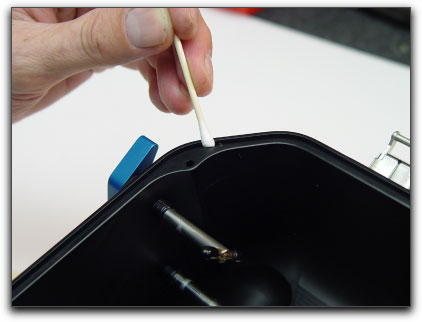
Photo by John Ellerbrock
Q-tips should always be on hand to clean out any dust or debris
On mechanical housings the controls are often rods that penetrate the housing to make contact with the controls of the camcorder. These rods also will need to be periodically lubricated, a job that usually takes only a few minutes. The only other maintenance necessary is to always rinse your housing whenever you can with fresh water so as to rid it of the remaining salt, which may have a corroding effect. Charge or discharge your camcorder and light batteries as needed and you will be always good to go.
Many new underwater shooters make the grave mistake of falling in love with their footage. This is no different than the home hobbyist who keeps everyone captive with the full 20 minutes of the cutting of the cake for their 2 year old's birthday. It is best to look at your underwater clips with a very critical eye. You just might have a full 35 minutes of a giant green turtle feeding upon the coral but that doesn't mean that you need to use all of it no matter how great the shots are. For underwater, documentary style films it is best to keep your clips very short. Generally, in postproduction I keep most of my clips limited from 3 to 6 seconds before changing angles, actions or subjects. I know that sometimes this process of cutting just kills you to have to do, but in the end, if you can be objective, you will find that the whole of your film has been improved tremendously.
There are many things to consider before venturing into the world of underwater videography. The first, and possibly the most important consideration is to evaluate honestly how prepared you are as a diver. If you are new to diving or haven't been in the water in a few years, than, for now, it is highly possible that getting into underwater videography or photography is not for you at this time. The new diver's time is much better spent mastering the diving skills that will make him/her a great videographer and diver. It is imperative that the budding diving videographer be completely comfortable in the water, and has a full and objective knowledge of his own skills and limitations. Ego under the water can lead to injury or a death sentence later on, maybe not now or tomorrow but eventually. Buoyancy control, the ability to hover over, under or by an object in the water, regardless of a specific depth in relationship to your subject might just be the most important skill that all divers, videographers, photographers or not, must learn. The mastering of this skill cannot be overly emphasized. While filming, poor buoyancy will not only create a shaky and unusable shot but also can also stir up the sand bottom and cause major damage to the delicate reefs and the ecology of the area. If you are a brand new diver you are probably still trying to practice maintaining buoyancy control, which can easily be affected by personal weighting, tank type, aluminum or steel, equipment being used, and dive conditions. That is a lot to deal with for a new or inexperienced scuba diver. Now imagine also trying to focus your attention on that $3,600 camcorder stuffed into that $3900.00 housing with those $2,000 HID lights attached by the $400 light arms. If you accidentally drop the system while reaching for your high-pressure inflator hose, you can very likely kiss the entire system goodbye and hope your home owners insurance will cover it. I maintain a special floater policy on my housing and camera just to cover this possibility. If you recognize in yourself that you are still at the stage where you frequently go to your inflator hose to change depth, if you have trouble maintaining a horizontal posture in the water and if you haven't yet learned to use breath control as a means to affect buoyancy than play it safe. Practice and master these skills until you and they become second nature before risking your hard earned money and equipment.
That said, underwater filming is an exciting and creative endeavor. Like most anything done well, it requires a great deal of time, patience and practice but there is nothing like it in the world when you hear the appreciative applause of your audience.
All pictures underwater pictures were taken from a single video frame shot by the author unless otherwise credited.
Steve Douglas, is an underwater videographer and contributor to numerous film festivals around the world. A winner of the 1999 Pacific Coast Underwater Film Competition, 2003 IVIE competition, 2004 Los Angeles Underwater Photographic competition, and the prestigious 2005 International Beneath the Sea Film Competition, Steve has also worked on the feature film "The Deep Blue Sea", contributed footage to the Seaworld parks for their Atlantis production, and is one of the principal organizers of the San Diego UnderSea Film Exhibition. Steve leads both underwater filming expeditions and African safaris with upcoming filming excursions to Kenya, Bali and the Red Sea. Feel free to contact him if you are interested in joining Steve on any of these trips. www.worldfilmsandtravel.com
copyright © Steve Douglas 2005
[Top]
© 2000 -2005 Apple
Computer, Inc. All rights reserved. Apple, the Apple logo, Final
Cut Pro, Macintosh and Power Mac
are either registered trademarks or trademarks of Apple. Other
company and product names may be trademarks of their respective
owners.
All screen captures, images, and textual references are the property and trademark of their creators/owners/publishers.
























